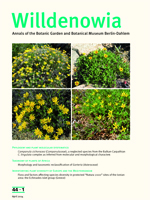In 1811, a paper by William Roxburgh was published in the Transactions of the Society for the Encouragement of Arts, Manufactures and Commerce. In it Roxburgh described four species used in dye manufacture in India and the surrounding region. This publication has been largely overlooked by plant taxonomists. Of the four names, one, Nerium tinctorium, had already been published. For the other three, Asclepias tinctoria, A. tingens and Indigofera coerulea, this represents the earliest place of valid publication. The application and typification of these names are reviewed. Some notes on other Roxburgh names appearing in the Transactions are included.
References
S. I. Ali
1958: Revision of the genus Indigofera L. from W. Pakistan and N.W. Himalayas. — Bot. Not. 111: 543–577. Google Scholar
Anonymous 1817:
M.D.F.L.S. William Roxburgh
&
S.A. Late
Superintendant of the Botanical Garden of the East India Company, in Bengal. — Pp. 1–15 in: The annual biography and obituary of 1816. — London: Longman, Hurst, Rees, Orme, and Brown. Google Scholar
R. Brown
1810: On the Asclepiadeae.
— [Preprinted and repaginated from] Mem. Wern. Nat. Hist. Soc. 1: 12–78, 1811. Google Scholar
N. Chambers
(ed.) 2010: The Indian and Pacific corre- spondence of Sir Joseph Banks, 1768–1820. Volume 3: Letters 1789–1792.—London: Pickering & Chatto. Google Scholar
N. Chambers
(ed.) 2011: The Indian and Pacific corre- spondence of Sir Joseph Banks, 1768–1820. Volume 4: Letters 1792–1798.—London: Pickering & Chatto. Google Scholar
J. Dupéron
1973:
Oleoxylon aginnense n.gen. n.sp., Pis- tacioxylon muticoides n.gen. n.sp., bois fossiles ter- tiaires de la région de Grateloup. — Bull. Soc. Bot. France 120: 311–330. Google Scholar
L. L. Forman
1997: Notes concerning the typification of names of William Roxburgh's species of phanero- gams. — Kew Bull. 52: 513–534.
http://dx.doi.org/10.2307/4110285
Google Scholar
P. I. Forster
1995: New names and combinations in Marsdenia (Asclepiadaceae: Marsdenieae) from Asia and Malesia (excluding Papuasia). — Austral. Syst. Bot. 8: 691–701.
http://dx.doi.org/10.1071/SB9950691
Google Scholar
IPNI 2013+ [continuously updated]: The International Plant Names Index. — Published at http://www.ipni.org [accessed 10 Oct 2013]. Google Scholar
D. J. Mabberley
1977: Francis Hamilton's commentaries with particular reference to Meliaceae. — Taxon 26: 523–540.
http://dx.doi.org/10.2307/1219645 Google Scholar
J. McNeill
,
F. R. Barrie
,
W. R. Buck
,
V. Demoulin
,
W. Greuter
,
D. L. Hawksworth
,
P. S. Herendeen
,
S. Knapp
,
K. Marhold
,
J. Prado
,
W. F. Prud'homme van Reine
,
G. F. Smith
,
J. H. Wiersema
&
N. J. Turland
(ed.) 2012: International Code of Nomenclature for algae, fungi, and plants (Melbourne Code) adopted by the Eighteenth International Botanical Congress Mel- bourne, Australia, July 2011. — Königstein: Koeltz Scientific Books. [Regnum Veg. 154]. Google Scholar
T. Robinson
2008: William Roxburgh: the founding father of Indian botany. — Chichester: Phillimore. Google Scholar
W. Roxburgh
1791: A botanical description, and drawing of a new species of Nerium (Rose-Bay) with the proc- ess for extracting, from it's [sic] leaves, a very beauti- ful indigo. — Pp. 39–44 in:
A. Dalrymple
(ed.), Orien- tal repertory 1(1). — London: East India Company. Google Scholar
W. Roxburgh
1795–1820: Plants of the coast of Coro- mandel. — London: East India Company. Google Scholar
W. Roxburgh
1805: [Letter from W. Roxburgh in Cal- cutta dated June 18, 1804]. — Trans. Soc. London En- cour. Arts 23: 407–414. Google Scholar
W. Roxburgh
1806: Observations on the culture, proper- ties and comparative strength of hemp, and other veg- etable fibres, the growth of the East Indies. — Trans. Soc. London Encour. Arts 24: 143–153. Google Scholar
W. Roxburgh
1811: Account of a new species of Nerium, the leaves of which yield indigo, with an engraving of the plant, and descriptions and engravings of the necessary apparatus for manufacturing the indigo. To which is added, a brief account of the result of various experiments made with a view to throw some addi- tional light on the theory of that artificial production. Also descriptions of two other plants which yield in- digo, and of one from Pegu, said to yield a green dye. — Trans. Soc. London Encour. Arts 28: 251–307. Google Scholar
M. Sanjappa
,
K. Thothathri
&
A. R. Das
1994 [“1991”]: Roxburgh's Flora indica drawings at Calcutta. — Bull. Bot. Surv. India 33: 1–232. Google Scholar
J. R. Sealy
1956: The Roxburgh Flora indica drawings at Kew. — Kew Bull. 11: 297–348, 349–399.
http://dx.doi.org/10.2307/4109049
Google Scholar





